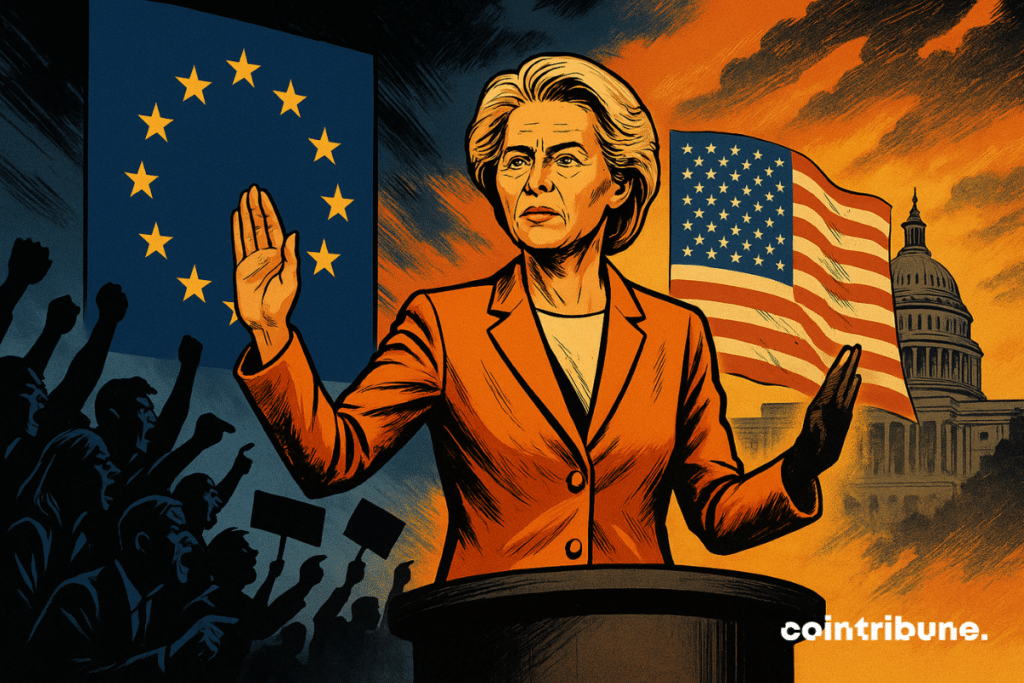US-EU Deal Sparks Political Tensions In Europe
In the midst of geopolitical reshuffling, the European Union and the United States have just ratified a trade compromise presented as a bulwark against escalation. Supported by Ursula von der Leyen, but strongly criticized by Mario Draghi, the text crystallizes a European dilemma : guaranteeing transatlantic stability or fully defending the continent’s industrial interests. Between diplomatic balance and tariff concessions, this new agreement revives the debate on Europe’s economic sovereignty.

In brief
- The European Union and the United States have signed a new trade agreement to prevent a tariff escalation between the two blocs.
- Ursula von der Leyen defends a “flawed but solid” compromise focused on transatlantic economic stability.
- The agreement maintains a 15 % cap on U.S. tariffs for several sensitive European products.
- Former ECB President Mario Draghi criticizes what he sees as a “resigned” Europe in the face of Washington’s demands.
The transatlantic agreement : a committed bet on stability
In an opinion piece published on August 24 in several major European newspapers, Ursula von der Leyen defended the tariff agreement between the European Union and the United States. She thus stated :
a deliberate choice: that of stability and predictability instead of escalation and confrontation.
This statement comes a few days after Mario Draghi’s criticism in Rimini, where he lamented a Europe “resigned” to American customs barriers. The agreement indeed avoids a rise in economic tensions between the two powers, but endorses maintaining American tariffs on several European export products.
Here are the main elements of the agreement defended by the European Commission :
- A 15 % tariff ceiling maintained by the United States on several categories of European products: cars, semiconductors, wood, pharmaceuticals ;
- There is no total removal of tariff barriers, but a framework to avoid any trade escalation ;
- Tariffs are taxes that, according to von der Leyen, “weigh on consumers and businesses”, “increase costs, reduce choice, and harm the competitiveness of economies” ;
- An implicit response to Draghi’s criticism, without naming him directly, but emphasizing that “the failure of the agreement would have been celebrated in Moscow and Beijing”.
By this stance, the European Commission assumes a strategic compromise : preserving transatlantic cooperation in a globally tense context, even if it means accepting an “imperfect” agreement on the substance.
This choice, presented as pragmatic, reflects a priority given to short-term macroeconomic stability, even though some see it as an excessive concession on European industrial interests.
Trade diversification : the other strategic axis of the European Union
Beyond the sole agreement with Washington, Ursula von der Leyen took advantage of her opinion piece to outline a global strategy: the diversification of the European Union’s economic partnerships.
“We have concluded trade agreements with Mexico and Mercosur, deepened relations with Switzerland and the United Kingdom. We have also concluded our talks with Indonesia and hope to reach an agreement with India by the end of the year,” she writes.
It is a way to signal that Brussels is not betting solely on the United States but seeks to build a multipolar economic safety network, with other blocs like the BRICS.
This direction reflects a desire to reduce strategic dependencies in an uncertain global context. The new alliances aim notably to open promising markets for European technological industries, some of which, such as blockchain, AI, and digital infrastructures, seek international outlets less exposed to regulatory tensions.
While the United States remains an indispensable partner, the European Commission seems to want to rebalance the trade and geopolitical scale by looking towards Asia, Latin America, and nearby neighbors.
The implications of this diversification are multiple. It could strengthen the resilience of the European economy against future frictions with Washington or Beijing, while creating new opportunities for digital companies, including those active in crypto, NFTs, or smart contracts. Provided that these agreements are quickly ratified and properly implemented, the Union could thus equip itself with a real strategic lever to defend its economic sovereignty.
Maximize your Cointribune experience with our "Read to Earn" program! For every article you read, earn points and access exclusive rewards. Sign up now and start earning benefits.
Diplômé de Sciences Po Toulouse et titulaire d'une certification consultant blockchain délivrée par Alyra, j'ai rejoint l'aventure Cointribune en 2019. Convaincu du potentiel de la blockchain pour transformer de nombreux secteurs de l'économie, j'ai pris l'engagement de sensibiliser et d'informer le grand public sur cet écosystème en constante évolution. Mon objectif est de permettre à chacun de mieux comprendre la blockchain et de saisir les opportunités qu'elle offre. Je m'efforce chaque jour de fournir une analyse objective de l'actualité, de décrypter les tendances du marché, de relayer les dernières innovations technologiques et de mettre en perspective les enjeux économiques et sociétaux de cette révolution en marche.
The views, thoughts, and opinions expressed in this article belong solely to the author, and should not be taken as investment advice. Do your own research before taking any investment decisions.